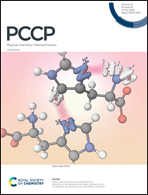Anisotropic thermal and electrical transport properties induced high thermoelectric performance in an Ir2Cl2O2 monolayer†
Abstract
In recent years, the energy crisis and global warming have been urgent problems that need to be solved. As is known, thermoelectric (TE) materials can transfer heat energy to electrical energy without air pollution. High-throughput calculations as a novel approach are adopted by screening promising TE materials. In this paper, we use first-principles calculations combined with the semiclassical Boltzmann transport theory to estimate the TE performance of monolayer Ir2Cl2O2 according to the prediction that Ir2Cl2O2 has potential as a good TE material via high-throughput calculations. The low thermal conductivities of 1.73 and 4.68 W mK−1 of Ir2Cl2O2 along the x- and y-axes are calculated, respectively, which exhibits the strong anisotropy caused by the difference in group velocities of low-frequency phonon modes. Then, the electronic transport properties are explored, and the figure of merit ZT is eventually obtained. The maximum ZT value reaches 2.85 (0.40) along the x-axis (y-axis) at 700 K, revealing that the TE properties of the Ir2Cl2O2 monolayer are highly anisotropic. This work reveals that the anisotropic layer Ir2Cl2O2 exhibits high TE performance, which confirms that it is feasible to screen excellent TE materials via high-throughput calculations.



 Please wait while we load your content...
Please wait while we load your content...